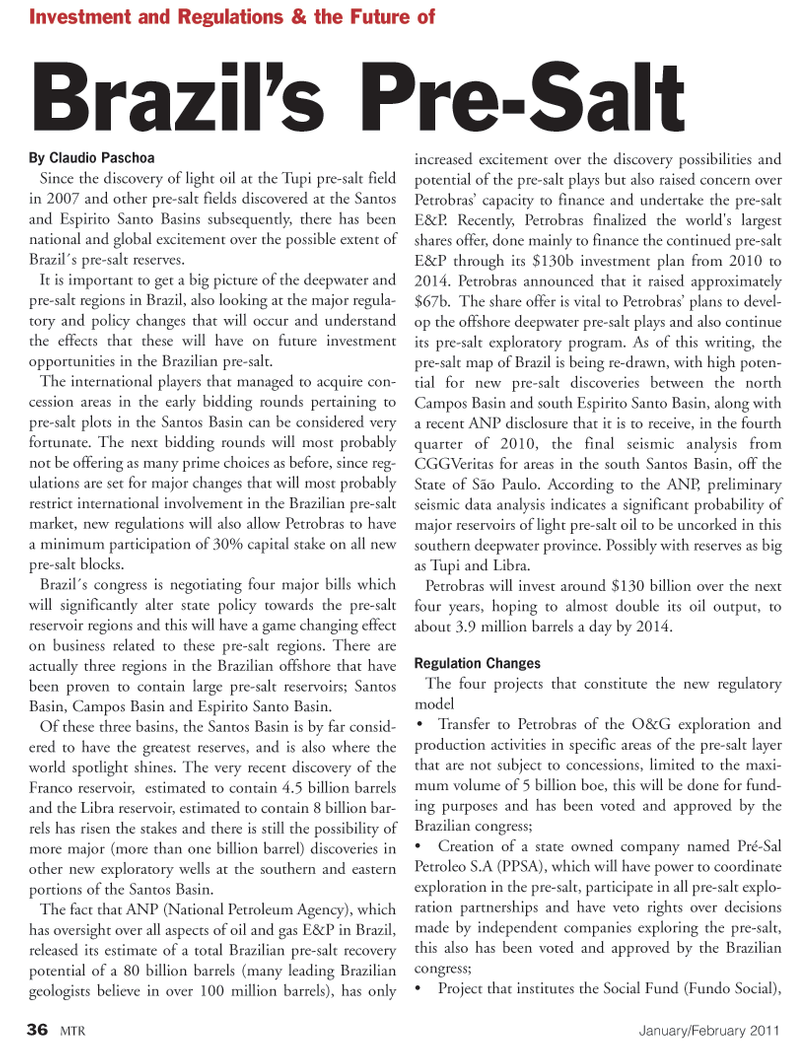
Page 36: of Marine Technology Magazine (January 2011)
Marine Salvage & Recovery
Read this page in Pdf, Flash or Html5 edition of January 2011 Marine Technology Magazine
36 MTR January/February 2011
By Claudio Paschoa
Since the discovery of light oil at the Tupi pre-salt field in 2007 and other pre-salt fields discovered at the Santos and Espirito Santo Basins subsequently, there has been national and global excitement over the possible extent of
Brazil´s pre-salt reserves.
It is important to get a big picture of the deepwater and pre-salt regions in Brazil, also looking at the major regula- tory and policy changes that will occur and understand the effects that these will have on future investment opportunities in the Brazilian pre-salt.
The international players that managed to acquire con- cession areas in the early bidding rounds pertaining to pre-salt plots in the Santos Basin can be considered very fortunate. The next bidding rounds will most probably not be offering as many prime choices as before, since reg- ulations are set for major changes that will most probably restrict international involvement in the Brazilian pre-salt market, new regulations will also allow Petrobras to have a minimum participation of 30% capital stake on all new pre-salt blocks.
Brazil´s congress is negotiating four major bills which will significantly alter state policy towards the pre-salt reservoir regions and this will have a game changing effect on business related to these pre-salt regions. There are actually three regions in the Brazilian offshore that have been proven to contain large pre-salt reservoirs; Santos
Basin, Campos Basin and Espirito Santo Basin.
Of these three basins, the Santos Basin is by far consid- ered to have the greatest reserves, and is also where the world spotlight shines. The very recent discovery of the
Franco reservoir, estimated to contain 4.5 billion barrels and the Libra reservoir, estimated to contain 8 billion bar- rels has risen the stakes and there is still the possibility of more major (more than one billion barrel) discoveries in other new exploratory wells at the southern and eastern portions of the Santos Basin.
The fact that ANP (National Petroleum Agency), which has oversight over all aspects of oil and gas E&P in Brazil, released its estimate of a total Brazilian pre-salt recovery potential of a 80 billion barrels (many leading Brazilian geologists believe in over 100 million barrels), has only increased excitement over the discovery possibilities and potential of the pre-salt plays but also raised concern over
Petrobras’ capacity to finance and undertake the pre-salt
E&P. Recently, Petrobras finalized the world's largest shares offer, done mainly to finance the continued pre-salt
E&P through its $130b investment plan from 2010 to 2014. Petrobras announced that it raised approximately $67b. The share offer is vital to Petrobras’ plans to devel- op the offshore deepwater pre-salt plays and also continue its pre-salt exploratory program. As of this writing, the pre-salt map of Brazil is being re-drawn, with high poten- tial for new pre-salt discoveries between the north
Campos Basin and south Espirito Santo Basin, along with a recent ANP disclosure that it is to receive, in the fourth quarter of 2010, the final seismic analysis from
CGGVeritas for areas in the south Santos Basin, off the
State of São Paulo. According to the ANP, preliminary seismic data analysis indicates a significant probability of major reservoirs of light pre-salt oil to be uncorked in this southern deepwater province. Possibly with reserves as big as Tupi and Libra.
Petrobras will invest around $130 billion over the next four years, hoping to almost double its oil output, to about 3.9 million barrels a day by 2014.
Regulation Changes
The four projects that constitute the new regulatory model • Transfer to Petrobras of the O&G exploration and production activities in specific areas of the pre-salt layer that are not subject to concessions, limited to the maxi- mum volume of 5 billion boe, this will be done for fund- ing purposes and has been voted and approved by the
Brazilian congress; • Creation of a state owned company named Pré-Sal
Petroleo S.A (PPSA), which will have power to coordinate exploration in the pre-salt, participate in all pre-salt explo- ration partnerships and have veto rights over decisions made by independent companies exploring the pre-salt, this also has been voted and approved by the Brazilian congress; • Project that institutes the Social Fund (Fundo Social),
Investment and Regulations & the Future of
Brazil’s Pre-Salt

 35
35

 37
37
